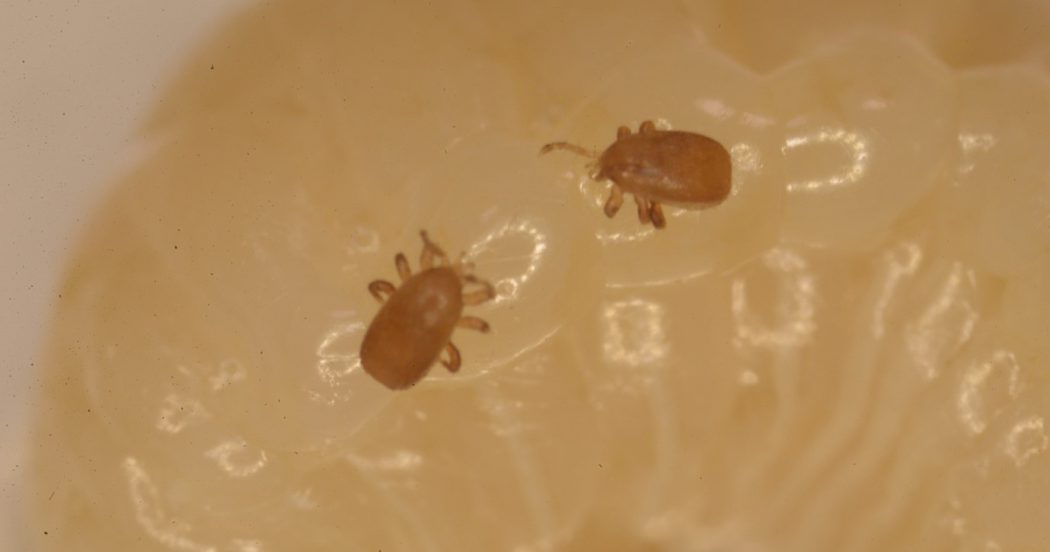Read along below!
An underestimated threat?
By: Maggie Gill
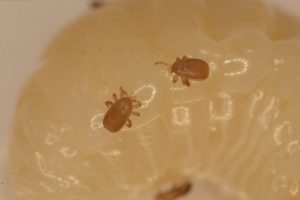
Tropilaelaps on bee larvae
Tropilaelaps are a parasitic mite that naturally infests the giant Asian honey bee species Apis dorsata. Much like varroa, they can live and reproduce in honey bee colonies feeding on brood, and again like varroa, they have jumped species from their native host to our Western honey bees Apis mellifera. However, unlike giant Asian honey bees, who have had millions of years to co-evolve with Tropilaelaps and develop natural defenses, Tropilaelaps have a devastating effect on our Western honey bees and cause significant colony losses. As they pose a such a threat to apiculture the World Organization for Animal Health (WOAH) list Tropilaelaps in the terrestrial animal heath code and they are a notifiable pest in many countries globally.
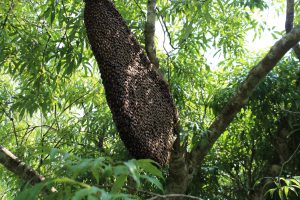
An Apis dorsata colony
The National Bee Unit (NBU) is the government body in England and Wales responsible for honey bee health and routinely carry out exotic pest inspections of honey bee colonies to monitor for Tropilaelaps. Last year saw a review of the standard operating procedures (SOP) used to monitor for Tropilaelaps after bee inspectors from the NBU traveled to Thailand and trialled detection techniques on colonies infested with Tropilaelaps. I was lucky enough to be one of those inspectors that traveled to Thailand.
The SOP used to detect Tropilaelaps comprised of four detection techniques:
- Brood uncapping with an uncapping fork: brood is removed from the cells using an uncapping fork and examined for mites.
- The bump method: frames of brood are bumped on a white tray to dislodge phoretic mites.
- Floor debris sampling: floor debris is collected and sent for laboratory analysis.
- Sticky floor inserts in conjunction with a miticide: the miticide kills any mites in a colony and these are collected on sticky floor inserts.
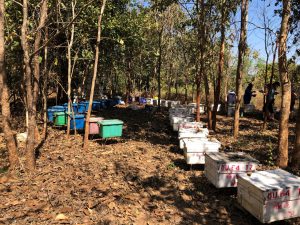
Typical Thai apiary
A hectic few weeks ensued, with us traveling around Chiang Mai and Lamphun provinces in northern Thailand inspecting colonies, trialling the SOP and refining it as we went. It soon became apparent that none of the techniques were adequate for detecting Tropilaelaps, despite being widely documented in WOAH manuals and codes. At the end of the first day, we could be found sitting in the lab at Chiang Mai University with our heads in our hands, because five of us had only managed to find two Tropilaelaps after several hours of using the original SOP techniques. We knew that the university colonies had fairly high levels of Tropilaelaps, but we just couldn’t find any, and when we did, they were so difficult to identify we spent a lot of time asking each other “is that small brown dot a Tropilaelaps or just a small brown dot?” If it was this difficult to find Tropilaelaps in Thailand, then what chance did we have in the UK?
The first adaptation we made was to use tweezers to uncap brood and look for Tropilaelaps. Using an uncapping fork damaged the brood, and we found that any fluids from the damaged brood we had uncapped would camouflage any Tropilaelaps. Tropilaelaps are also really fast and could hide amongst the brood that were pulled out with an uncapping fork. Tweezers allowed us to pull out the brood carefully without damaging it, allowing for a thorough inspection. We also discovered that gently blowing over the open brood would make any Tropilaelaps in the cells emerge and run over the comb.
The bump method had always been problematic in the UK, as beekeepers were concerned about how damaging the technique was to the brood used. The bump method was very unreliable at detecting Tropilaelaps and we would often bump the frames on the tray and dislodge a few mites but see far more mites still running around on the comb, and it also killed the brood in the bumped frames. When we returned to the colonies 24 hours later, we saw large amounts of brood on the hive floor that the bees had pulled out.
Collecting floor debris samples presented its own set of challenges. Debris samples would typically be sent to the lab and washed through a series of increasingly finer sieves, with Tropilaelaps being caught in the finest of these sieves. As insect and arachnid exoskeletons are made of chitin, which floats in alcohol, these sieves and their contents would then be placed in 100% ethanol, causing any mites in the debris sample to float and therefore be identifiable. Or at least that was the theory! During the planning stage we had discussed our plans with researchers in Thailand and they had said that Tropilaelaps didn’t float in alcohol, but this didn’t make sense to us as flotation techniques are commonly used to detect Tropilaelaps. Surely someone, somewhere had checked this before? It turned out, no, the anecdotal information was correct and we were unable to get Tropilaelaps to float!
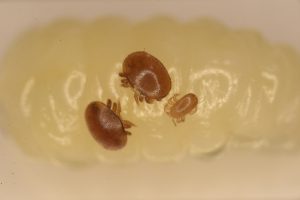
Varroa (left) and Tropilaelaps (right) on a bee larvae.
This left us with the final detection technique of miticides and sticky floor inserts to trial. We had taken a range of varroa treatments with us, but as temperatures were at the upper limits of the manufacturer’s recommendations (28-35oC), we were concerned that if we did use these treatments the colonies would die or abscond and therefore, only natural mite drop was recorded. We had always assumed that a beekeeper would be able to see Tropilaelaps amongst hive debris. Yet even with only a small amount of debris and our newly acquired expert ‘Tropilaelaps spotting skills’, we found it incredibly difficult to see Tropilaelaps in the field and needed to return to the lab with good lighting and microscopes to look for Tropilaelaps on the sticky floors.
Out of the four detection techniques we had set out to trial in Thailand, we were left with only brood uncapping using tweezers and sticky floor inserts, and both techniques now required considerably more time to deploy effectively. Fortunately, we had also decided to trial the varroa detection techniques of an alcohol wash, an icing sugar roll and CO2 monitoring to see if these could reliably detect Tropilaelaps. The alcohol wash was great for detecting varroa but disappointingly unreliable at detecting Tropilaelaps and CO2 monitoring proved ineffective for both. It was therefore a relief to find that an icing sugar roll reliably detected the presence of Tropilaelaps in a colony and was a relatively quick and non-lethal method. We’re not 100% sure why this technique is so effective, but we suspect that the sugar clogs up the Tropilaelaps and the bees grooming in the sugar dislodges them. We also suspect that Tropilaelaps are just too small and light to be reliably washed off bees in an alcohol wash. Whatever the reason, this part of the trial meant that we now had two field and a laboratory technique for reliably detecting Tropilaelaps, and this was a massive relief after our depressing first day. It also meant that we could return to the UK and be confident that our field and laboratory work would detect Tropilaelaps if it were introduced accidentally.
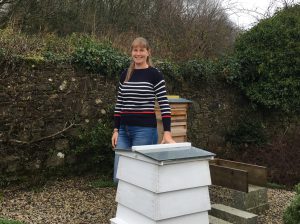 Maggie Gill is a senior scientist at Defra and worked at the National Bee Unit for 10 years as a Seasonal Bee Inspector and as the Regional Bee Inspector for Wales. Maggie is currently working on research into Tropilaelaps survival and transmission, the efficacy of miticides for Tropilaelaps detection and the monitoring of volatile organic compounds in honey bee colonies to detect subclinical disease, pest incursions and environmental contamination. She has kept bees for almost 20 years and is also a small-scale queen and nucleus producer.
Maggie Gill is a senior scientist at Defra and worked at the National Bee Unit for 10 years as a Seasonal Bee Inspector and as the Regional Bee Inspector for Wales. Maggie is currently working on research into Tropilaelaps survival and transmission, the efficacy of miticides for Tropilaelaps detection and the monitoring of volatile organic compounds in honey bee colonies to detect subclinical disease, pest incursions and environmental contamination. She has kept bees for almost 20 years and is also a small-scale queen and nucleus producer.




